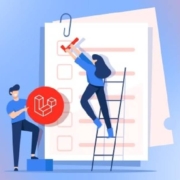Sanitization vs Validation in Laravel: What’s the Difference in 2025?
In the evolving landscape of Laravel development, data integrity and security remain top priorities. A common area of confusion for developers—especially those building robust applications—is the distinction between Sanitization vs Validation in Laravel. Although they sound similar, their roles in the development process are fundamentally different and equally important.
In 2025, as Laravel continues to improve its data handling capabilities, it’s essential for teams and any professional Laravel development company to fully understand the difference and use both processes correctly. This guide breaks it down and explains where Laravel Validation fits into your overall application strategy.
What Is Laravel Validation?
Laravel Validation refers to the process of checking incoming data to ensure it meets specific rules and conditions before storing or processing it. For example, checking whether an email is correctly formatted, or a password has the required length and characters.
Laravel makes validation easy with built-in features such as:
- Rule-based syntax (required, email, max:255)
- Form Request classes for reusable validation
- Custom validation rules and messages
Whether you’re validating user input in a registration form or an API payload, validation in Laravel ensures that only acceptable data is processed.
What Is Sanitization in Laravel?
Sanitization, on the other hand, is the process of cleaning or transforming data before or after validation. This could include:
- Trimming whitespace
- Escaping special characters
- Removing harmful input like script tags
- Converting strings to integers or booleans
In Laravel, sanitization isn’t as built-in as validation, but you can handle it using middleware, custom request classes, or third-party packages like Laravel Purifier or spatie/laravel-data.
Key Differences: Sanitization vs Validation in Laravel
Let’s break down the main distinctions between these two:
Purpose:
- Sanitization cleans the data.
- Validation checks if data is acceptable.
Timing:
- Sanitization typically happens before validation.
- Validation occurs after sanitization to ensure data meets specific criteria.
Function:
- Sanitization ensures safety.
- Validation ensures accuracy.
Example:
If a user submits a name input like ” John Doe “
- Sanitization would trim the spaces to become “John Doe”
- Validation would confirm that the name isn’t empty and is a valid string format
By using both, you improve not only performance but security and reliability—something every serious laravel development company integrates into their build process.
Implementing Sanitization in Laravel Projects
While Laravel doesn’t have native sanitization rules like it does for validation, developers can integrate it in several ways:
- Custom Form Requests: Add sanitization logic in the prepareForValidation() method.
- Middleware: Create a middleware that sanitizes request data globally or on specific routes.
- External Libraries: Tools like HTMLPurifier or Laravel Data offer easy-to-implement sanitization.
Adding these practices into your development flow not only enhances security but makes your validation Laravel layer more reliable and lean.
Best Practices in 2025: Using Both Together
To develop secure and scalable Laravel apps in 2025, here’s how to optimize the use of both sanitization and validation:
- Always sanitize before validating: Ensure clean data before rule checks.
- Use custom request classes: Laravel’s FormRequest allows separation of concerns.
- Combine sanitization with DTOs or value objects: This helps manage typed and cleaned data better.
- Hire professional help: A trusted laravel development company will implement the right balance of sanitization and validation based on your project scope.
Why It Matters More Than Ever
With stricter compliance regulations (GDPR, HIPAA, etc.), and increasing concerns around data leaks and breaches, it’s not enough to just use Laravel Validation. Cleaning input with sanitization helps protect your application from malicious payloads, injection attacks, and inconsistent data that can harm your business logic or database structure.
Validation in Laravel ensures correctness, but sanitization ensures safety.
Conclusion: Balance Is Key in Laravel Data Handling
As Laravel evolves, so should your development practices. Understanding Sanitization vs Validation in Laravel empowers you to build applications that are both secure and user-friendly. Using them together creates a two-step defense system: first cleaning the data, then verifying it.
Whether you’re scaling an enterprise product or launching a SaaS MVP, partnering with a skilled Laravel development company will help you implement these processes properly. These experts know how to embed both validation and sanitization in the architecture from the ground up.

